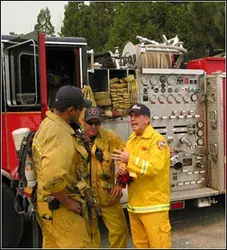 (October 13, 2009) Department of Homeland Security Science and Technology sends Ph.D. fireman to help firefighters seek—and get—tougher, safer gear.
(October 13, 2009) Department of Homeland Security Science and Technology sends Ph.D. fireman to help firefighters seek—and get—tougher, safer gear.
After years of "squirting water and throwing dirt," Tom Foley, a veteran of battling blazes for CAL FIRE (California Department of Forestry and Fire Protection), has seen his fair share of sales pitches and has been exposed to a number of technologies used with varying results. He also brings a wealth of operational knowledge to his new position as CAL FIRE's Southern Region Deputy Chief, knowledge that the Department of Homeland Security Science and Technology Directorate (S&T) is looking to understand better. Unknown to Foley, folks at S&T had begun the shift to put him and his first responder community into a position of power to speak directly about their needs.
S&T is forging a new relationship with our nation's first responders in an effort to enhance, enable, and support their mission objectives.
Last June, in Northern Virginia, the First Responders Capstone Integrated Product Team (IPT) held its kickoff summit. Attending were some three dozen first responders–among them Foley, who was coping with his newfound responsibility to advise the government–and thus, industry–through the Wildfire Firefighters Working Group. "This marked a total paradigm shift for the first responder community," said Foley, who realized that the Capstone IPT process puts the first responders in the driver's seat to steer product development. But for product development, was the Department of Homeland Security–and more important, industry–ready to let first responders point the way?
For years, firefighters, law enforcers, bomb squads, and emergency medical personnel have endured sales pitches from a multitude of vendors that bring their "latest and greatest" products to the table in an attempt to capture the limited resources of the first responders. By leveraging S&T's IPT process, first responders are able to turn the tables and now have a voice to communicate the challenges they face in real-life, day-to-day operations. The First Responders Capstone IPT is a new voice for the first responders to communicate their needs.
No one was happier to see the First Responders IPT born than Dr. Thomas Cellucci. As the Department's Chief Commercialization Officer, the charismatic physical chemist has been promoting first responders' needs…and the private sector's ability to meet them by bringing better products, systems, and software to market. It's a mission that Cellucci–a corporate executive, pioneer in commercializing emerging technology, and volunteer firefighter–is now tackling with professional and personal zeal, as Tom Foley would soon discover.
Foley is open about his realization that first responders will need an entirely new set of cognitive skills to communicate their needs, instead of listening to another sales pitch. "If you need help developing requirements, feel free to call me up and show me your work environment. I'm not afraid of getting dirty," Cellucci offered to Foley.
Cellucci's promise would soon be tested. In late August, Los Angeles County would face its largest wildland fire in recorded history: the Station Fire, which had begun in the mountains north of L.A. Within a week, the blaze was joined by raging wildfires in Riverside County. Recalling Cellucci's promise, the CAL FIRE Deputy Chief decided to call in the offer and show Cellucci the challenges faced in fighting wildland fires, especially in the urban interface.
Within 24 hours, Cellucci and his associate, Mark Protacio, were on the scene at the Station Fire base camp, suiting up with a crew (photo). "My guys couldn't believe it," Foley recalls. After speaking with a number of firefighters and incident commanders, Cellucci and Protacio boarded a helicopter for a bird's-eye understanding of the wildland–urban interface. The next morning, after guzzling coffee with the crews at a predawn briefing, Cellucci and Protacio hopped into an SUV for a first-hand look at the burn area. After spending time at Foley's office, they returned to Washington with a clearer understanding of what it takes to manage, suppress, and survive a wildfire.
Due to the wealth of information received from the visit, Cellucci and Protacio have been working closely with Foley and CAL FIRE to write and edit Operational Requirements Documents (ORDs) to help first responders describe a number of problems that technology could solve. Cellucci's office serves as a government-to-business broker, sharing Department-generated and vetted ORDs as potential business opportunities for vendors.
So far, the Wildfire Firefighters Working Group has begun development of ORDs for
1. a respirator suitable for wildland firefighting
2. personal protective equipment that's highly fire-retardant (like Nomex®), yet breathable (like GORE-TEX®)
3. a personal alert and tracking system to warn when the air's carbon monoxide level is unsafe and when a metal fence is electrically charged, and also to notify incident commanders when a first responder is in distress
4. a situational awareness system that would let a field commander see what's on the ground while letting firefighters update and correct information as conditions change
5. a system to assess and track how well a jurisdiction is prepared for a crisis.
Other first responders have written ORDs for an interoperable communications system; a portable, stand-alone water purifier; blast-resistant autonomous video gear; and more. "A lot of the technology is already out there," says Foley. "The ORDs help vendors package it for us."
"We're helping vendors do what they do best: Create products people need at prices they'll pay," adds Cellucci. If a technology has already been developed in a government lab, we'll help bring it to market. For taxpayers, vendors, and first responders, it's a win–win–win."
For Foley, the bottom line is about results. "I don't care whether a better product comes from a government lab or a private company," he says. "I just want my brothers and sisters in the fire service to be safe."
To request more information about this story, please e-mail st.snapshots@hq.dhs.gov.
